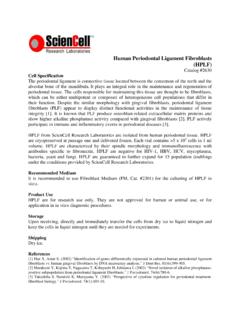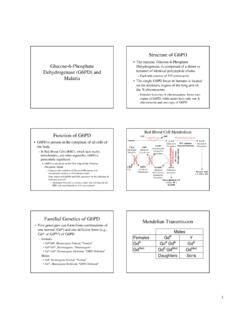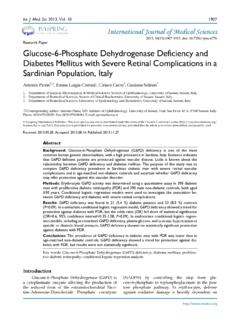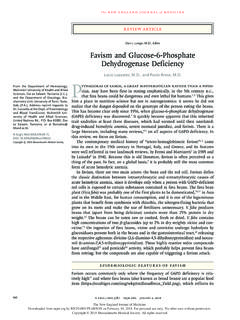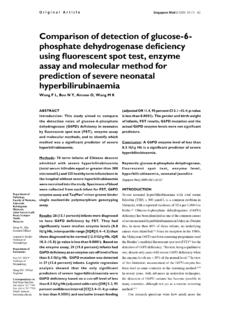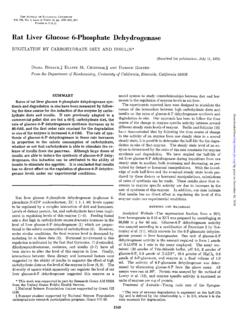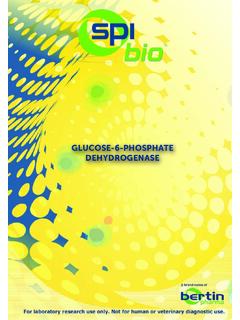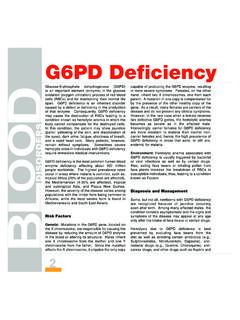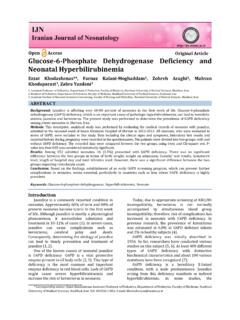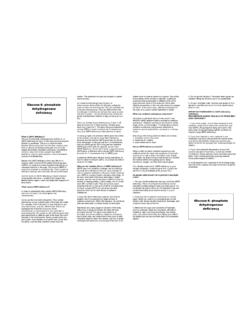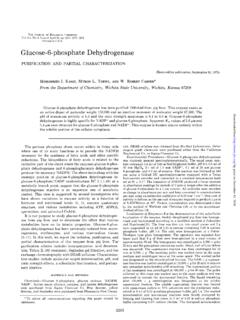Transcription of Glucose 6 phosphate Dehydrogenase Assay (G6PDH)
1 1 Glucose -6- phosphate Dehydrogenase Assay (G6 PDH) Cat. No. 8428 100 Tests in 96-well plate Introduction Glucose -6- phosphate Dehydrogenase (G6 PDH) is a cytosolic enzyme that catalyzes the first step in the pentose phosphate pathway (PPP). The PPP pathway is critical for maintaining the cofactor nicotinamide adenine dinucleotide phosphate (NADPH) and for the production of ribose-5- phosphate . G6 PDH deficiency, the most common enzyme deficiency worldwide, predisposes individuals to non-immune hemolytic anemia. This colorimetric Assay is based on Glucose -6- phosphate Dehydrogenase catalyzed oxidation of Glucose -6- phosphate , in which the formed NADPH can convert a nearly colorless probe to an intensely colored product, which exhibits maximum absorbance at 440nm, is proportional to the amount of G6 PDH in the sample.
2 Kit Components Cat. No. # of vials Reagent Quantity Storage 8428a 1 Assay buffer 10 mL 4 C 8428b 1 G6 PDH standard mL -20 C 8428c 1 Developer (10X) mL -20 C 8428d 1 NADP mL -20 C 8428e 1 WST mg -20 C 8428f 1 Substrate mL -20 C Product Use Glucose -6- phosphate Dehydrogenase Assay kit could measure G6 PDH activity of samples from cells and tissue. This product is for research purposes only and not for use in animals, humans, or diagnostic procedures. Quality Control Data from Glucose -6- phosphate Dehydrogenase Assay of G6 PDH solutions with concentrations ranging from to 1 U/ml show a linear relationship between OD440nm and G6 PDH activity (Figure 1).
3 Shipping Shipped on dry ice. 2 Sample Preparation 1. Developer solution (1X): dilute developer (10X) (8428c) in Assay buffer (8428a) (1:10). 2. WST solution: reconstitute each vial of WST with mL Assay buffer (8428a). Vortex briefly and keep in the dark at -20 C until use. For longer storage, we suggest that you aliquot and store the reconstituted WST solution at -20 C, avoid repeated freeze/thaw cycles. Procedure (96-well plate) A. Preparation of Glucose -6- phosphate Dehydrogenase standard 1. Add 1 L of G6 PDH standard (8428b) to 99 L of Assay buffer (8428a) to make a mL solution of 2 U/mL G6 PDH. 2. Obtain 7 test tubes, add 25 L of Assay buffer (8428a) into each tube and label them #1 through #7.
4 3. Add 25 L of the 2 U/mL into tube #1 and mix well to get the 1U/mL G6 PDH standard. 4. Transfer 25 L of the 1U/mL G6 PDH standards from tube #1 to tube #2 and mix well to get the G6 PDH standard. 5. Repeat step 4 for tubes #3-6 to serially dilute the G6 PDH standards. Do not add any G6 PDH to tube #7, which serves as blank. 6. Obtain a 96-well test plate, prepare 2 replicates (A, B) of each G6 PDH standard by aliquoting 10 L/well of each G6 PDH standard into duplicate wells of the 96-well test plate, according to the following plate format: B. Preparation of test samples 1. Cells or Tissues can be homogenized in 4 volumes of the Assay buffer (8428a).
5 Centrifuge the samples at 13,000 g for 10 minutes to remove insoluble material. The soluble fraction may be assayed directly. 2. Endogenous NADH or NADPH from cell or tissue extracts would generate background for the G6 PDH Assay . To remove the NADH or NADPH background, same amount of sample can be tested in the absence of substrate. 3. Samples should be serial diluted to make sure the readings are within the standard curve range. Prepare test samples to a final volume of 10 L/well on the 96-well flat bottom plate. C. Working reagent preparation and measurements 1. For each well of reaction, prepare working reagent by mixing 70 L Assay buffer (8428a), 5 L developer solution (1X), 5 L NADP (8428d) and 5 L WST solution, 5 L substrate(8428f).
6 Without adding substrate into the well containing test samples for control. 2. Add 90 L of working reagent mix into each well of the 96-well plate containing G6 PDH standard, test samples, blank and test samples for control. Incubate for 30 minutes at room temperature in dark. 3. Read the absorbance at 440 nm with an ELISA plate reader. #1 #2 #3 #4 #5 #6 #7 A 1 U/ml U/ml U/ml U/ml U/ml U/ml Blank B 1 U/ml U/ml U/ml U/ml U/ml U/ml Blank 3 D. Calculations 1. Average the OD440nm of duplicate wells of each G6 PDH standard, test sample and blank. Subtract the OD440nm value of the blank from the OD440nm values obtained with all other standard and samples to get OD440nm value.
7 2. Based on the calibrated OD440nm of the G6 PDH standard, make a standard curve by plotting OD440nm as a function of G6 PDH activity (See Figure 1 for a typical standard curve). Determine the equation and R2 value of the trend line. 3. For samples requiring control without substrate, subtract the OD440nm without substrate value from the OD440nm with substrate value and use this OD440nm value to determine the sample G6 PDH activity from the standard curve. 4. Suppose the equation of the trend line of the standard curve is BAxy , calculate the G6 PDH activity of test samples as follows: Figure1. A typical G6 PDH standard curve measured by ScienCell Glucose -6- phosphate Dehydrogenase Assay kit OD440nm A[G6 PDH] = y = + R = OD440nm G6 PDH activity (U/mL)



